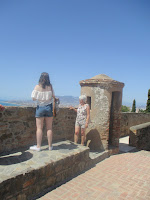First time
trip to Malaga with Sis Jean and friend Judy. Stayed just off the Place de la
Merced, birthplace of Picasso, in a wonderful apartment overlooking the castle
on the hill owned by the lovely Vincentes -
father and son. Amongst the many advantages were the nearness to restaurants
and shops off the square, most of the old town and the beach being within
walking distance, ample affordable taxis and wall to wall sunshine.
 |
| Judy n Jean with new friend Pablo |
Malaga is
dominated by Castillo de Gibralfaro and the fortification of Alcazaba. We could
see the castle on the hill from the balcony of our apartment. Two thirds of the
way up the steep path to the castle is an impressive viewing platform. Not only
are the views spectacular but on a clear day you can see the coast of Africa.

The Castle
was built in the 14th. Century to house troops and protect the Alcazaba It was
named after a lighthouse at its peak (Jabal-Faruk, the light mountain).
Although it was used by the Phoenicians and Romans, in 1340 the Nasrid King
Yusuf I made the place into a fortress. The main courtyard and houses the
Interpretation Centre housing the history of the castle. It is possible to walk
the high battlements to the tall tower with its panoramic views.


According to
Arab historians the Alcazaba was built between 1057 and 1063 at the
instructions of Badis, King of the Berber Taifa of Granada. The building's
military components make it one of the most important Muslim works in Spain
today.
Málaga's
Roman Theatre, in front of the Alcazaba, is one of the remaining symbols of
Roman Hispania in the city. The Theatre has been returned to its original use
and different types of shows take place inside.
In much the
way the Castle dominates the hill the Cathedral dominates the old town. Its
full name is Nuestra Señora de la Encarnación (Our Lady of Incarnation).
The foundations were laid around 1530 and work ended in the 17th century, although
it is unfinished and lacks coping on the main façade and the south tower. The
missing tower has led to it being popularly known as La Manquita (one-armed).


The green spaces between the castle and the main beach are like miniature botanic gardens in themselves, similarly the Cathedral gardens.


This in contrast to the main beach, not the best on the Costa - murky water, few resources but OK for an hour or two on a recliner under an umbrella.

The trip to Gibraltar was a smidge long but the luxury air con coach
ambled through the Costas down the coast. As we had never been before it proved
an interesting trip. It is believed that as Neanderthals developed into
Homosapians and moved north through Africa the caves in Gib was believed to be
their first European settlement. After negotiating the Spanish and British
border controls (Brexiteers get used to this soon no longer the EU Citizens
fast track for us!) your on La Roc.
After a
wander round town, somewhat reminiscent of Cheltenham, we boarded a mini bus
with driver and tour guide par excellent Jesus (heisus) – he said we were to
tell people we had been driven round Gib by Jesus :) . It’s a trip well worth
taking :)
The sensible
people of Gib led a very enthusiastic ‘In’ campaign during the EU Referendum,
but they had more than most to lose. Having held off one blockade by Spain with
the help of Morocco they are about to face another demand for its return.
Amongst their current privileges:
- Subsidised marine fuel forms a mainstay of their economy with Med shipping calling in to refuel;
- Major tax concessions;
- If their offspring pass their A levels they get shipped to GB and their Uni fees paid, providing they finish their course, with no other strings attached;
- Advantageous OAP social care.
Churchill
reckoned that the Brits would be on Gib as long as the monkeys were there, they’re
still there. Must admit, geographically, Gib should be part of Spain – but then
Spain controls the Canary Isles, just off the coast of Africa, and makes
similar financial/economic concessions to them. Post colonial hangovers forever
causing problems.

The trip around the rock again took in amazing views and as with the stunning St Michael's Caves, pictures can’t do it justice. The acoustics in the main cave are so good the chamber is now used for concerts.

The war caves are more depressing. Around 1k
people died constructing the miles of war caves hewn out of the rock by hand held
pneumatic drills. In the end Franco refused to bomb and Mussolini failed to
turn up so the rock was never attacked.

All too soon it was time for the trip back to Malaga and tiffin :-p






















No comments:
Post a Comment